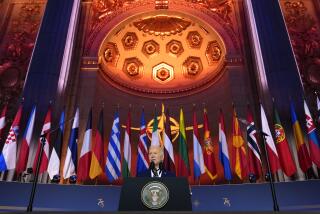NATO at twilight
- Share via
The North Atlantic Treaty Organization was once a force to reckon with. During the Cold War, it possessed formidable capabilities and real cohesion. No more. As a serious military enterprise, the alliance has all but ceased to exist. The “other” NATO -- the National Assn. of Theatre Owners -- probably wields more clout.
Founded in 1949 with 12 members, NATO had one overarching aim: to defend Western Europe and prevent World War III. Keeping the Americans in, the Germans down and the Russians out offered a formula for achieving that aim. Over the course of four decades, the formula worked brilliantly.
Once the Soviet threat disappeared, the European nations making up the core of the alliance wasted no time claiming their peace dividend. They cut defense budgets and shed military capacity. For example, the German army, which had 12 divisions in 1989, today maintains the equivalent of three.
Meanwhile, back at NATO headquarters, the iron law of bureaucratic self-preservation kicked in. Justifying the alliance’s continued existence became a cottage industry. Even as armies shrunk, new missions proliferated.
One of the new missions was to expand. Today, NATO consists of 26 members, with Albania, Croatia and Macedonia lined up to join next. Still more candidates -- Serbia, Montenegro, even Georgia and Ukraine -- are knocking at the door. Adding members provided a mechanism for incorporating what had been Eastern Europe and even parts of the former Soviet Union into Europe proper. But enlargement diluted NATO’s actual ability to defend itself. Rather than a collective security organization, the alliance became something more akin to a political club, far more adept at convening conferences than at organizing itself for war.
Urged on by Washington, alliance leaders simultaneously began to look “out of area” -- projecting power to enhance security beyond NATO’s boundaries. Behind this concept lay the vague notion of the alliance providing a posse of sorts to help the world’s superpower-sheriff enforce global law and order.
The Balkan wars of the 1990s provided a preliminary opportunity to test this idea. The results were less than reassuring: In 1999, it took 11 weeks of ever-intensifying bombing for mighty NATO to pry Slobodan Milosevic’s two-bit army out of Kosovo. An allied reluctance to contemplate anything approximating close combat became apparent.
The ongoing Afghan war against Al Qaeda and the Taliban is now providing a second and more demanding test case. This test demonstrates just how much the alliance’s capabilities and solidarity have withered.
In Afghanistan, NATO is failing. Nominally, all 26 alliance members are contributing to the war effort, with some 43,000 total troops deployed. In reality, stripping away the forces provided by the United States, Britain and Canada, the alliance has fielded barely 20,000 soldiers -- this to pacify a country that is 50% larger than Iraq. Many national contingents, Germany’s being the most prominent, operate under restrictions that make them unusable except in areas where relative security exists.
U.S. officials call for the allies to do more -- more troops with fewer strings attached. But Europe lacks trained soldiers, lacks adequate stores of equipment and above all lacks political will. European publics have an exceedingly limited appetite for sending their fellow citizens to chase insurgents in other parts of the world. European governments, with Germany again providing a good illustration, reflect the will of their people.
U.S. Secretary of Defense Robert M. Gates warns that NATO risks becoming a “two-tier” alliance, one tier consisting of members willing to carry their fair share of the load, the second tier consisting of free riders. His warning comes too late. The two-tier arrangement already exists, with the great majority of member states content to occupy the lower tier.
NATO is no longer a fighting organization. Keeping the Americans in, the Germans down and the Russians out no longer demands the sort of exertion that was required half a century ago. If the alliance retains any value, it is as an institution for consolidating European integration and prosperity.
No amount of browbeating by the United States is going to change that. The Bush administration is kidding itself if it expects Europeans to save the day in Afghanistan. To think of NATO as a great alliance makes about as much sense as thinking of Pittsburgh as the Steel City or of Detroit as the car capital of the world. It’s sheer nostalgia.
It’s time to jettison the capital letters: NATO has become nato.
More to Read
Sign up for Essential California
The most important California stories and recommendations in your inbox every morning.
You may occasionally receive promotional content from the Los Angeles Times.










